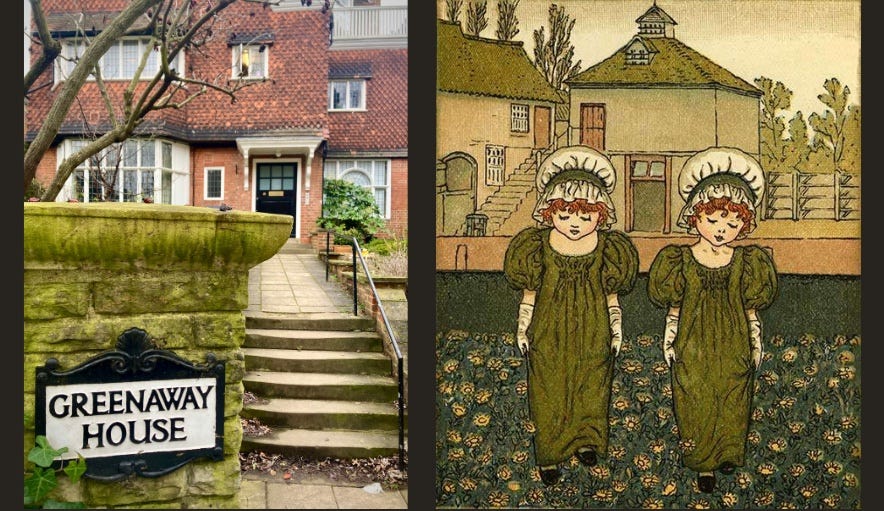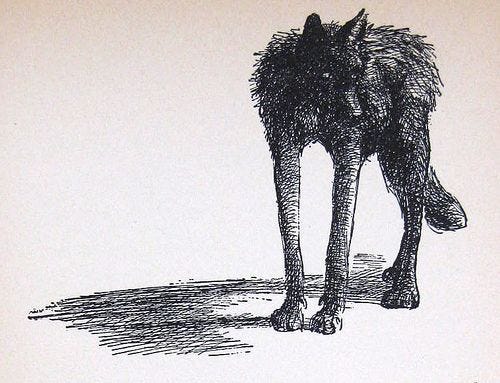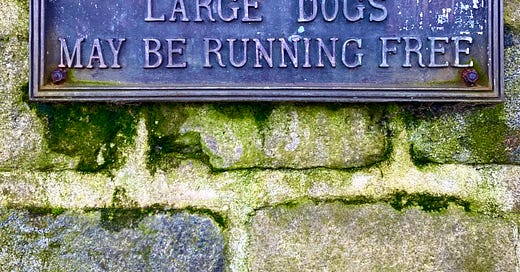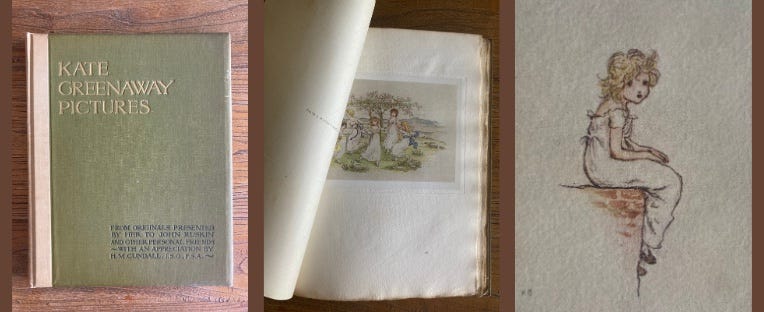There’s something here for you if: you are a parent or carer interested in the science of reading and the changes to the way reading is going to be taught around the world, or you are interested in the history of children’s book illustration. And also if: you enjoy historical fiction set in the late 50s about uptight Brits, or contemporary novels set in bookshops, or dystopian stories where the relationships between humans and animals prove a guiding light.
If the newsletter is truncated, click on "View entire message".
Dear Reader,
Do Not Enter, Large Dogs May Be Running Free
Don’t worry, you are warmly invited as usual to my first newsletter of the year despite the menacing sub-heading. This is a sign I spotted during a long wintry walk in London last month. It was attached to an imposing wall surrounding a house on substantial grounds in the famous, sprawling suburb of Hampstead, and made me think of Gothic novels like The Wolves of Willoughby Chase by Joan Aiken and The Hounds of the Baskervilles by Arthur Conan Doyle.
It’s also an accurate description of my brain at the moment. Although I’m feeling creatively energetic, and writing something new alongside refining two manuscripts coming out next year — those good dogs are running wild and free, as it were — I’m also feeling burnt-out by the book industry and my walls are up. It’s why my newsletters are less frequent and why I have a light presence on social media at the moment. For a number of years I’ve gone hard and tried a lot of different things, and now my brain is telling me to retreat, reassess, and write.
Reassessing the way we’ve done things for a long period is a theme picked up a couple of times in this newsletter, related to (1) opening a bookshop, and (2) the way we teach children how to read.
In today’s newsletter I’d love to share the stand-out books & podcasts that have filled my cup in recent weeks.
6 Novels in Comparative Pairings
It’s Britain, it’s cold — no, seriously — in the late 50s & early 60s, and conformity is having a little shake-up but the stiff upper lip is holding on for dear life in these two elegantly told stories: Small Pleasures by Clare Chambers (2020) & The Land in Winter by Andrew Miller (2024).
Small Pleasures, set in the late 50s, is about a life-changing few months for a single journalist in her late thirties who investigates a claim of a virgin birth. While her home life is stifled by a difficult mother, she becomes entangled in a superficially ideal but tragically complicated family. The strict 1950s, beautifully and humorously rendered, creates delightful tension when a forbidden romance begins. The Land in Winter is set in the freezing British winter of 1962 and follows secretive GP Eric, his insecure and naive young wife, Irene, and their neighbours, a struggling, inexperienced farmer called Bill and his unconventional, unwell wife, Rita. The four wrestle with their marriages, their pasts, and the Big Freeze — one of the coldest winters on record in the UK at the time. I loved being under the spell of this one, especially as it coincided with being in London in the snow.
Working in a bookshop is either really good for you — see Welcome to the Hyunam-Dong Bookshop by Hwang Bo-Reum (2022), or may even be the death of you — see Death of a Bookseller by Alice Slater (2023). As an ex-bookseller I got a lot out of both novels.
In Welcome to the Hyunam-Dong Bookshop, Yeongju has reassessed her life. She’s left her marriage and high-flying career to open a small neighbourhood bookshop. She takes an open-minded and considered approach to running her shop, detailing each decision and graciously reflecting on her successes and mistakes. We’re drawn into the lives of her regular customers and staff. The tone and tempo was something quite different for me, it’s gentle and pensive and I wasn’t sure that I loved it but nevertheless I read it in a fascinated state from cover to cover.
Death of a Bookseller has a completely different energy. It’s a brisk, disturbing, amusing portrait of two twenty-something female booksellers who rub each other up the wrong way from their first meeting. The backbone of the story is an interesting examination of what the fervour for true crime stories looks like from different points of view, but it’s also an accurate and funny account of working in a bookshop and being a young writer. Sympathy swings manically between the two, no matter how dark their deeds or how infuriating their behaviour. Great fun.
Always work with animals and children, if you can do them justice. Ali Smith can. Gliff by Ali Smith (2024) is my favourite novel so far this year. It’s a faithful, gut-wrenching portrait of young siblings in peril and a profound rendering of the mess our planet is in. As much as it articulates with few characters this ‘brave new world’, and can feel like reading the words of a surreal nightmare, there's a passage here that made my heart lift like nothing else I’ve read for ages. This is a stirring and perfectly troubling novel.
I Am Rebel by Ross Montgomery (2024) is a children’s book that everyone in the UK will be familiar with because it won the Waterstones Children’s Book Prize and while I was in London it was plastered all over the underground, a wondrous sight to behold. I wish I could travel back in time to give this book to my son any time from the ages of 8 to 12 when all he wanted to read were adventure stories told from an animal’s point of view. We found plenty of them back then too but this would have been a cracker. If you read this to your child as a bedtime story: good luck, bring tissues.
“I am a good dog. I know this because Tom tells me I am good all the time,
and Tom knows everything.”
History Corner: Kate Greenaway
I spent a lot of my childhood in Hampstead (the London suburb of the ‘large dogs running free’ sign) because it’s where my grandparents lived. They were excellent fun and their house was full of interesting, ‘precious’ things. We were allowed to handle whatever caught our eye; there was no ‘don’t touch that, you’ll break it’. One of my earliest memories is sitting with a book of illustrations by Kate Greenaway, published in 1921. I loved turning the tissue paper, was intrigued by the curiously melancholy faces of the children, and wanted to enter the worlds they danced in.
While I was looking at the book, it’s probable that my grandfather said something like, ‘Our family knew Kate Greenaway; they were friends,’ but if he did I was too caught up with the apple trees and dreamily solemn children. It’s a small connection but one I now think about alongside my great love of children’s book illustration.
My great-great-grandfather was an art dealer known around London as “Little Brown” (his name was Ernest Brown), and he’s been credited with popularising the picture book ‘gift book’ in the early 1900s. His son Oliver’s diary, which makes for great reading (ice-skating, cocktails, dancing, and drives to the seaside in the 1930s) includes the line “[Ernest] loved illustrators . . . He always called on old Sir John Tenniel on his birthday and on Kate Greenaway on her birthday.”
Kate died at only 55 in 1901 and had stepped away from her illustrating career in the 1890s having made a huge mark. I wonder what conversations she and Ernest had about picture books that influenced his championing of them.
It’s fair to say that although at one time Kate Greenaway was the most imitated illustrator in the world, and influenced not just picture books but also fashion, one of the reasons she remained in the public consciousness is because of the Kate Greenaway Medal for Illustration, established in 1955. It is now called the Carnegie Medal for Illustration, after late-in-life philanthropist Andrew Carnegie, in order to align it with the medal for writing and strengthen the brand. Having watched a documentary about Carnegie, who at the last possible moment sought to atone for his appalling treatment of working families and his life-long extreme greed for wealth by showering his money around, I just wonder what I’m missing here. But what do I know about branding (not a lot).
For Kate Greenaway, the sanctity of childhood was always at the forefront of her mind. As an artist she was committed to providing a rural idyll for the children of the Second Industrial Revolution. She had a true affinity with and respect for children.
For a deep dive into this interesting woman and her wide influence, I recommend this well-researched piece on a blog called The Kissed Mouth.

Finally, some listening recommendations for you
Sold a Story is a deep dive into how and why the method of teaching children how to read, which had its origins in New Zealand research, changed several decades ago, and what the science of reading discovered in the meantime, and why it has been such a struggle to change it again. This is a US podcast but it is relevant to what’s been happening in Australia and to the changes that have now been made to the way reading is taught here. But if you’re a parent or carer who needs a faster set of answers than a 12-episode deep dive, I have another recommendation for you:
Your Kids Next Read episode 188: Real Talk About Reading. In this episode, experienced teacher librarian Megan Daley and author A.L. Tait discuss changes to the Australian primary school reading programme. They explain what is meant by whole word reading and predictable text (the old way), and what the science of reading tells us is the best longterm way to teach reading, via decodable texts. Well worth your time.
The Book Show: Markus Zusak on The Book Thief This is the final episode of the Book Show’s ‘My Biggest Book’ series in which authors reflect on their defining work. A charming, honest episode.
Lucky Boy (nb. the later part of this short series is subscription-only) With an education setting but on a different, disturbing topic, I must offer a content warning: child sexual exploitation and grooming. I was drawn to this in part because I went to school in this suburb at the time it occurred, the late 1980s.
Stalked is a BBC podcast with episodes released weekly about a digital intruder who watched, threatened, and impersonated a young woman. It’s by the excellent journalist Caroline Cadwalladr.

Thank you for reading.
If you enjoy Voracious and you’d like to support me in some way, I’d love it if you’d consider borrowing, buying, or writing a review of one of my books, or sharing this newsletter with a friend.












How very fascinating about your family and Kate Greenaway! Love this blog as always :)
My daughter’s teacher was telling us about those changes to the way reading is being taught - so definitely interested in checking out those episodes you’ve mentioned.